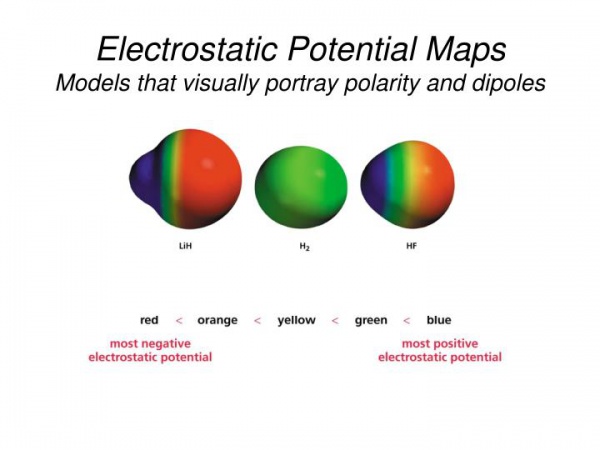Difference between revisions of "WebMO Electrostatic Potential maps"
Jump to navigation
Jump to search
| Line 6: | Line 6: | ||
The figure below shows an example of the electrostatic potential maps for LiH, H<sub>2</sub>, and HF. | The figure below shows an example of the electrostatic potential maps for LiH, H<sub>2</sub>, and HF. | ||
| − | ::*H<sub>2</sub>, the electrons are evenly distributed among the two H-atoms, | + | ::*H<sub>2</sub>, the electrons are evenly distributed among the two H-atoms (green = neutral), |
::*LiH, being an ionic compound, the 1s valence electron is transferred to the H-atom showing a clear positive charge (blue - on left) and negative charge (red - on right), | ::*LiH, being an ionic compound, the 1s valence electron is transferred to the H-atom showing a clear positive charge (blue - on left) and negative charge (red - on right), | ||
::*HF, being a covalent bond with the highly electronegative F-atom showing showing a clear positive charge (blue - on left) and negative charge (red - on right). | ::*HF, being a covalent bond with the highly electronegative F-atom showing showing a clear positive charge (blue - on left) and negative charge (red - on right). | ||
Revision as of 14:23, 23 April 2020
(4/23/20, bes)
Exercise 5: Electrostatic Potential Maps
Electrostatic potential maps show the electron distribution (ie. the composite wavefunction for all electrons) within a molecular frame. Did you get that ? <--these pictures are a visual representation of the composite electron wavefunctions.
The figure below shows an example of the electrostatic potential maps for LiH, H2, and HF.
- H2, the electrons are evenly distributed among the two H-atoms (green = neutral),
- LiH, being an ionic compound, the 1s valence electron is transferred to the H-atom showing a clear positive charge (blue - on left) and negative charge (red - on right),
- HF, being a covalent bond with the highly electronegative F-atom showing showing a clear positive charge (blue - on left) and negative charge (red - on right).
Note: these maps are "surface" maps...electrostatic potential surface maps...and represent what the electron distribution looks like from a external perspective.
Using WebMO/Gaussian please complete the following table by optimizing the geometry based the stated level of theory and basis set:
